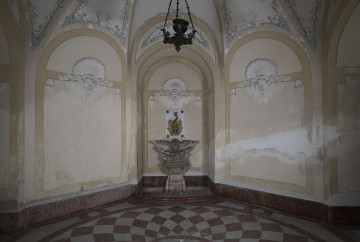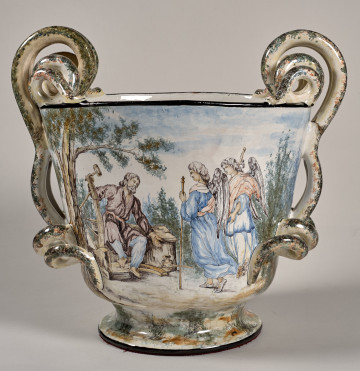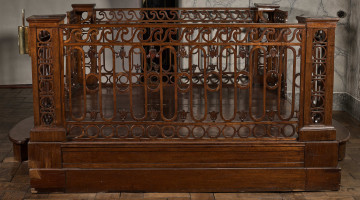
Grotto in the Tower
Castle Museum in Łańcut
Part of the collection: Fabrics
A white flag with a cross and sewn-on lilies is located in the Red Corridor of the Łańcut castle. Originally, in the interwar period, it was located in the Great Hall and was placed on the south wall near the Bellona sculpture. A gonfalon – as it is professionally called – is a rectangular-shaped flag attached to a horizontal bar, suspended from a spar. Banners of this type sometimes had cut-outs that were called “tails”. Originally it was used as a processional flag. In the foreground, you will notice a red cross that is mistakenly called the Cross of the Order of the Holy Sepulchre. In reality, this is the Jerusalem Cross – a large cross with four Greek crosses in the corners. In symbolism, this cross is meant to symbolise the 5 wounds of Jesus Christ. From 1099 to 1291, it was the coat of arms of the Kingdom of Jerusalem, and since 1217 it has been used as the symbol of the Custody of the Holy Land. At the corners, the attention is drawn to four lilies, which may give the first thought that they are lilies referring to the French royal ruling house of de Bourbon. However, this is not the case at all. Lilies also have religious significance. In Christian tradition, the lily is said to have arisen from the tears of Eve, who despaired over her expulsion from Paradise, but it also foreshadows the Virgin Mary’s participation in the redemption of the world. In this case, lilies, symbolise innocence, modesty, and God’s majesty. The Custody of the Holy Land is an autonomous administrative unit of the Order of Friars Minor which, to this day, is dedicated to promoting and disseminating knowledge of the Holy Land as the cradle of Christianity. The object is dated to around the 2nd half of the 19th century. It is not known when it appeared in the castle in Łańcut and who donated it. It is likely that the flag was in the possession of Rev. Roman Sanguszko of Slavuta, who, while returning from exile in Siberia, received this flag as a souvenir in the Holy Land.
Author / creator
Dimensions
height: 87 cm, width: 83 cm
Object type
Fabrics
Technique
embroidery
Material
silk
Origin / acquisition method
decyzja administracyjna
Creation time / dating
Creation / finding place
Owner
Castle Museum in Łańcut
Identification number
Location / status

Castle Museum in Łańcut

1882 — 1886
Castle Museum in Łańcut

1st half of the 19th century
Castle Museum in Łańcut
DISCOVER this TOPIC
Castle Museum in Łańcut
DISCOVER this PATH
Educational path